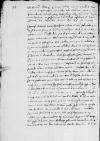Letter #1435
[Ioannes DANTISCUS] to [Mikołaj GRABIA?]Löbau (Lubawa), 1536-04-07
Manuscript sources:
| ||||||||||||
Text & apparatus & commentaryPlain textText & commentaryText & apparatus
Generose domine, amice carissime. Salutem et omnem felicitatem.
Quod iam aliquot humanissimis Dominationis Vestrae litteris non responderim, aliud in causa non fuit, quam quod exspectarem occasionem mihi dari, qua aliquem meorum ad curiam mitterem, quam ad praesens nactus, nolui committere, ut nuntius meus sine meis Dominationem Vestram accederet, cui omnia fausta et felicissima precor habeoque gratiam, quod me de multis, quae in aula pro novis habebantur, certiorem reddiderit, idipsum, ut crebrius faciat, impense oro, quo nullum mihi gratius officium praestare poterit, quoque non parum me sibi devinctum et ad referendum aliquando gratias efficiet. Ceterum rescripsi
Quam optime valere ex animo cupio.
Rogo me reverendo atque written over et⌈etatqueatque written over et⌉ eximio domino praeposito et probably

 BCz, 244, p. 88
BCz, 244, p. 88